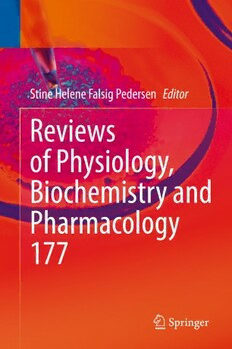
Reviews of Physiology, Biochemistry and Pharmacology PDF
Preview Reviews of Physiology, Biochemistry and Pharmacology
Stine Helene Falsig Pedersen Editor Reviews of Physiology, Biochemistry and Pharmacology 177 Reviews of Physiology, Biochemistry and Pharmacology Volume 177 Editor-in-Chief StineHelene FalsigPedersen,DepartmentofBiology,UniversityofCopenhagen, Copenhagen,Denmark SeriesEditors EmmanuelleCordat,DepartmentofPhysiology,UniversityofAlberta,Edmonton, Alberta,Canada DianeL.Barber,DepartmentofCellandTissueBiology,UniversityofCalifornia SanFrancisco,CA,USA JensLeipziger,DepartmentofBiomedicine,AarhusUniversity,Aarhus,Denmark LuisA.Pardo,MaxPlanckInstituteforExperimentalMedicine,G€ottingen,Germany ChristianStock,DepartmentofGastroenterology,HannoverMedicalSchool,Hannover, Germany Nicole Schmitt, Department of Biomedical Sciences, University of Copenhagen, Copenhagen,Denmark MarthaE.O’Donnell,DepartmentofPhysiologyandMembraneBiology,Univer- sityofCalifornia,DavisSchoolofMedicine,Davis,CA,USA The highly successful Reviews of Physiology, Biochemistry and Pharmacology continuetoofferhigh-quality,in-depthreviewscoveringthefullrangeofmodern physiology, biochemistry and pharmacology. Leading researchers are specially invited to provide a complete understanding of the key topics in these archetypal multidisciplinary fields. In a form immediately useful to scientists, this periodical aimstofilter,highlightandreviewthelatestdevelopmentsintheserapidlyadvanc- ingfields. 2016ImpactFactor:4.769,5-YearImpactFactor4.893 2019EigenfaktorScore:0.00067,ArticleInfluenceScore:1.570 Moreinformationaboutthisseriesathttp://www.springer.com/series/112 Stine Helene Falsig Pedersen Editor Reviews of Physiology, Biochemistry and Pharmacology Editor StineHeleneFalsigPedersen DepartmentofBiology UniversityofCopenhagen Copenhagen,Denmark ISSN0303-4240 ISSN1617-5786 (electronic) ReviewsofPhysiology,BiochemistryandPharmacology ISBN978-3-030-61494-2 ISBN978-3-030-61495-9 (eBook) https://doi.org/10.1007/978-3-030-61495-9 © The Editor(s) (if applicable) and The Author(s), under exclusive license to Springer Nature SwitzerlandAG2020 Chapter“StationaryandNonstationaryIonandWaterFluxInteractionsinKidneyProximalTubule: MathematicalAnalysisofIsosmoticTransportbyaMinimalisticModel”islicensedunderthetermsof theCreativeCommonsAttribution4.0InternationalLicense(http://creativecommons.org/licenses/by/4. 0/).Forfurtherdetailsseelicenceinformationinthechapter. Thisworkissubjecttocopyright.AllrightsaresolelyandexclusivelylicensedbythePublisher,whether thewholeorpartofthematerialisconcerned,specificallytherightsoftranslation,reprinting,reuseof illustrations, recitation, broadcasting, reproduction on microfilms or in any other physical way, and transmissionorinformationstorageandretrieval,electronicadaptation,computersoftware,orbysimilar ordissimilarmethodologynowknownorhereafterdeveloped. The use of general descriptive names, registered names, trademarks, service marks, etc. in this publicationdoesnotimply,evenintheabsenceofaspecificstatement,thatsuchnamesareexempt fromtherelevantprotectivelawsandregulationsandthereforefreeforgeneraluse. Thepublisher,theauthors,andtheeditorsaresafetoassumethattheadviceandinformationinthisbook arebelievedtobetrueandaccurateatthedateofpublication.Neitherthepublishernortheauthorsorthe editorsgiveawarranty,expressedorimplied,withrespecttothematerialcontainedhereinorforany errorsoromissionsthatmayhavebeenmade.Thepublisherremainsneutralwithregardtojurisdictional claimsinpublishedmapsandinstitutionalaffiliations. ThisSpringerimprintispublishedbytheregisteredcompanySpringerNatureSwitzerlandAG. Theregisteredcompanyaddressis:Gewerbestrasse11,6330Cham,Switzerland Acknowledgements Contributionstothisvolumehavepartlybeenpersonallyinvited,withkindsupport oftheserieseditorsD.L.Barber,E.Cordat,J.Leipziger,M.E.O’Donnell,L.Pardo, N.Schmitt,C.Stock. v Contents TheRoleofChemokineReceptorsinRenalFibrosis. . . . . . . . . . . . . . . 1 FengleiWu,ChiSun,andJianquanLu InflammatoryBiomarkersforCardiovascularRiskStratification inFamilialHypercholesterolemia. . . . . .. . . . .. . . . . .. . . . . .. . . . . .. 25 AfsaneBahrami,LucaLiberale,ZˇeljkoReiner,FedericoCarbone, FabrizioMontecucco,andAmirhosseinSahebkar BeyondtheParadigm:NovelFunctionsofRenin-ProducingCells. . . . . 53 AnneSteglich,LindaHickmann,AndreasLinkermann,StefanBornstein, ChristianHugo,andVladimirT.Todorov RoleofASIC1ainNormalandPathologicalSynapticPlasticity. . . . . . 83 DalilaMangoandRobertNistico` StationaryandNonstationaryIonandWaterFluxInteractions inKidneyProximalTubule:MathematicalAnalysisofIsosmotic TransportbyaMinimalisticModel. . . . . . . . . . . . . . . . . . . . . . . . . . . . 101 ErikHviidLarsenandJensNørkærSørensen Correctionto:StationaryandNonstationaryIonandWaterFlux InteractionsinKidneyProximalTubule:MathematicalAnalysis ofIsosmoticTransportbyaMinimalisticModel. . . . . . . . . . . . . . . . . . 149 ErikHviidLarsenandJensNørkærSørensen vii RevPhysiolBiochemPharmacol(2020)177:1–24 https://doi.org/10.1007/112_2020_21 ©SpringerNatureSwitzerlandAG2020 Publishedonline:9August2020 The Role of Chemokine Receptors in Renal Fibrosis FengleiWu,ChiSun,andJianquanLu Contents 1 Introduction................................................................................... 2 2 CXCChemokineReceptors.................................................................. 8 2.1 CXCR1/CXCR2........................................................................ 8 2.2 CXCR3................................................................................. 9 2.3 CXCR4................................................................................. 9 2.4 CXCR6................................................................................. 10 3 C-CChemokineReceptors................................................................... 11 3.1 CCR1................................................................................... 11 3.2 CCR2................................................................................... 12 3.3 CCR7................................................................................... 12 4 CX3CChemokineReceptor.................................................................. 13 4.1 CX3CR1................................................................................ 13 5 OtherChemokineReceptors.................................................................. 13 6 Discussion..................................................................................... 14 References......................................................................................... 16 Abstract Renal fibrosis is the final pathological process common to any ongoing, chronic kidney injury or maladaptive repair. Renal fibrosis is considered to be closely related to various cell types, such as fibroblasts, myofibroblasts, T cells, andotherinflammatorycells.Multipletypesofcellsregulaterenalfibrosisthrough therecruitment,proliferation,andactivationoffibroblasts,andtheproductionofthe extracellular matrix. Cell trafficking is orchestrated by a family of small proteins called chemokines. Chemokines are cytokines with chemotactic properties, which areclassifiedinto4groups:CXCL,CCL,CX3CL,andXCL.Similarly,chemokine receptors are G protein-coupled seven-transmembrane receptors classified into FengleiWuandChiSuncontributedequallytothiswork. F.WuandJ.Lu(*) DepartmentofNephrology,QidongPeople’sHospital,Nantong,JiangsuProvince,China C.Sun DepartmentofPain,AffiliatedHospitalofNantongUniversity,Nantong,JiangsuProvince, China 2 F.Wuetal. 4 groups: XCR, CCR, CXCR, and CX3CR. Chemokine receptors are also impli- cated in the infiltration, differentiation, and survival of functional cells, triggering inflammation that leads to fibrosis development. In this review, we summarize the different chemokine receptors involved inthe processesoffibrosis in different cell types.Furtherstudiesarerequiredtoidentifythemolecularmechanismsofchemo- kinesignalingthatcontributetorenalfibrosis. Keywords Chemokinereceptors·Macrophages·Myofibroblasts·Renalfibrosis· Tcells 1 Introduction Renal fibrosis is widely regarded as a common pathway contributing to end-stage renal disease, characterized by aberrant activation and the development of renal fibroblasts and overproduction of proteins of extracellular matrix (ECM) (Meng etal.2014).Duringfibrosis,thekidneyisstimulatedbyvariouspathogenicfactorsin diversediseasesincludingtrauma,infection,inflammation,bloodcirculationdisor- der,andimmuneresponse.Fibrosiscanbeviewedasanaberrantwoundhealing,in which there is progression rather than scar recovery following damage, and fibro- blastsarecentraltothisprocess.Fibrosisiscloselyrelatedtotissueregenerationand inflammation, which is mediated by specific types of cells, including epithelial, endothelial, fibroblast, pericyte, myofibroblast, and inflammatory cells (Duffield 2014). Pathogenic factors such as drug poisoning, high blood pressure, diabetes, and infection can cause damage to the intrinsic cells which can release some cytokines.Thesecytokinesattractaseriesofinflammatorycellsinbloodtoinfiltrate the mesangial, vascular, and interstitial areas. In response to inflammatory media- tors,theintrinsiccellsreleasenephrotoxiccytokinesandgrowthfactors,causingthe proliferation of fibroblasts and furtherdifferentiation tomyofibroblasts intherenal interstitium. With the constant stimulation of cytokines and growth factors, fibro- blasts continue to proliferate and synthesize extracellular matrix (ECM) compo- nents.Kidney-derivedcells,suchasmesangialcells,glomerularepithelialcells,and renal tubular epithelial cells, can also be differentiated into myofibroblasts. More thanhalf oftherenal myofibroblastshavebeenconfirmedtobederivedfrom local fibroblasts,whilemostoftheremainderarederivedfrombonemarrow,endothelial- to-mesenchymal transition program, and epithelial-to-mesenchymal transition pro- gram(LeBleuetal.2013).Theimpairedimbalanceinthesynthesisanddegradation ofECMcomponentspromotestheformationoffibroustissue,eventuallyleadingto glomerularsclerosis,renalfibrosis,andformationofpersistentscars. Abundant evidences have shown that most chemokines and their receptors are crucial participants in the progression of renal fibrosis. Chemokines are chemotac- tically categorized into four groups of cytokines based on the location of two TheRoleofChemokineReceptorsinRenalFibrosis 3 cysteineresiduesintheirsequence:XCL,CCL,CXCL,andCX3CL(Griffithetal. 2014).ChemokinereceptorsareGprotein-coupledseven-transmembranereceptors classifiedintofourgroups:XCR,CCR,CXCR,andCX3CR.Chemokinereceptors are expressed in various leukocytes and immune cells. Chemokines and their receptorsplayanessentialroleinvariousphysiologicalandpathologicalprocesses (Griffithetal.2014). Thechangeofchemokineexpressionatthelesionsiteisalsoanimportantpartof renalfibrosis.HighexpressionofCCL2inkidneyhasaverystrongassociationwith theprogressionofrenaldisease,andtheblockadeofCCL2receptor(CCR2)reduces interstitial fibrosis (Kitagawa et al. 2004). High expression levels of CXCL10 and CXCL9 have been reported in glomerular cells in kidney biopsies of patients with membranoproliferative andcrescenticglomerulonephritis (Romagnanietal.2002). CCL18 is also identified as one of the central chemokines in glomerulonephritis (Brix et al. 2015). In hypertension mice, significantly CX3CL1 mRNA expression increasesinwholekidney,andtheproteinlocalizestotubularepithelialandvascular endothelialcells(Shimizuetal.2011). Chemokinesareinvolvedinthedevelopmentofinflammatorycellsinpatholog- ical and physiological processes. CXCR2 regulates neutrophils recruitment in response to CXCL1 (Drummond et al. 2019). CXCL8, as another ligand of CXCR1/2,canalsomodulateneutrophilmigration(Zuniga-Traslavinaetal.2017). CXCR3mainlyexpressesonactivatedTh1cells,NKcells,macrophages,andother immunecellswhichmayplayanimportantroleinrenalfibrosis(Campanellaetal. 2008). CXCR4 participates macrophages differentiation (Ding et al. 2019) and T cellsrecruitment,soasCXCL16/CXCR6(Seoetal.2019;Wehretal.2013;Zhang etal.2009).CCL3andCCL5caninteractwithCCR1toattractmacrophagesandT cells(Olszewskietal.2000)(Fig.1). Myeloidcells and organ-resident cells are also involved in the process of tissue fibrosis. Circulating bone marrow-derived fibroblast precursors were chemotactic and differentiated under the control of CXCL16/CXCR6 and CCL2/CCR2 (Chen et al. 2011; Xia et al. 2013). CXCR4 is well known for its role in the homing of progenitorcellsintothebonemarrow(Doringetal.2014)(Table1). Some fibrosis-related molecule productions are also directly or indirectly regu- lated by chemokines. CXCL8 was a potent suppressor of MMPs which acted their proteolyticactivityintissuefibrosis(Milovanovicetal.2017).CXCR4couldinduce pro-fibrotic collagen in some diseases such as cancer (Dong et al. 2019). CXCR4 inducedplatelet-derivedgrowthfactor-βtopromotepulmonaryfibrosisbytraffick- ingofcirculatingfibrocytes(Aonoetal.2014).Th17-derivedcytokineswererelated tofibrosisandcouldbeinducedbyCCR2(Gurczynskietal.2019).CXCR6could activate human pulmonary fibroblasts to produce collagen production (Ma et al. 2019). Accumulatingevidencesindicatethatchemokinereceptorsarekeyregulatorsof renal fibrosis in diseased kidneys. Therefore, the purpose of this summary is to provideasuccinctoverviewofrecentprogressinthepathogenesisofrenalfibrosis onchemokinereceptors.
